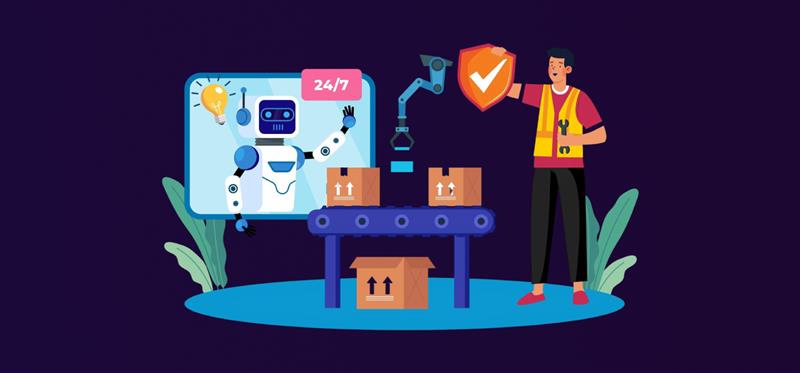How RPA is Revolutionizing Transportation and Logistics in the USA?
Is your supply chain future-ready? With the rise of e-commerce, demand for real-time tracking and razor-thin delivery windows is increasing, while traditional logistics models struggle to keep up. Enter Robotic Process Automation (RPA)—a digital workforce changing the very DNA of how transportation and logistics operate in the USA.
From eliminating manual paperwork to ensuring on-time freight dispatches, RPA in the logistics industry is no longer just a back-office tool. Rather, it’s a frontline driver of efficiency, cost savings, and agility in the logistics sector.
What Is RPA and Why Does It Matter in Logistics
Robotic Process Automation uses software bots to automate high-volume, rule-based tasks without human intervention. RPA in transportation and logistics plays a focal role in streamlining operations such as:
Order Processing and Scheduling
RPA bots extract order data, validate inventory, and schedule dispatches automatically within ERP and TMS systems. This eliminates manual errors and accelerates the order-to-delivery timeline.
Shipment Tracking
Bots track shipments across multiple carriers, consolidate status updates, and send real-time alerts to customers, reducing support workload and improving delivery visibility.
Carrier Selection
RPA compares rates, delivery timelines, and service terms to select the best carrier for each order. It also automates booking and record updates, ensuring cost-effective decisions.
Invoice Auditing
Bots verify freight invoices by cross-checking shipment details and contracts, instantly flagging any errors. This reduces overpayments and speeds up approval workflows.
Regulatory Compliance Reporting
RPA auto-fills and submits compliance forms, logs driver hours, and generates required reports, ensuring timely, accurate filings with minimal manual effort.
Unlike traditional automation that requires deep API integration, RPA mimics human actions on user interfaces. This means legacy systems in warehouses, ERP platforms, and freight booking portals can be automated without rebuilding infrastructure.
The Urgent Need for RPA in Transportation and Logistics
The USA logistics and transportation sector is under intense pressure to deliver faster, cheaper, and more transparently than ever before. With over $2 trillion in annual logistics spend, even small inefficiencies can lead to significant financial and operational losses. Challenges faced by the industry include:
Rising Costs
The USA logistics industry continues to face rising fuel costs and increased labor expenses. Automation helps offset these challenges by handling mundane tasks without adding a headcount.
Customer Expectations
With the growing demand for real-time updates and same-day deliveries, manual processes fall short. RPA enables faster order processing, accurate tracking, and proactive communication.
Regulatory Pressure
Companies must comply with strict regulations from bodies like FMCSA and CBP. RPA ensures timely and accurate reporting, minimizing the risk of penalties or delays.
Data Overload
Modern logistics generates massive data from GPS, sensors, and TMS platforms. RPA bots can collect, clean, and feed this data into analytics tools to unlock insights that improve operations.
Need for Scalability
As logistics businesses grow, so do their process volumes. RPA scales effortlessly, ensuring consistency and speed across regions and time zones without needing major infrastructure changes.
These pressures demand faster and error-free operations, something manual processes can’t guarantee. RPA in logistics offers an answer by providing 24/7 operational support, increased visibility, and improved turnaround times.
Top Use Cases of RPA in Transportation and Logistics
Let’s break down the major areas where robotic process automation in logistics is creating a measurable impact:
1. Freight Booking and Scheduling
Logistics coordinators often spend hours navigating various platforms to compare rates, check availability, and book carriers. RPA bots can scrape data from multiple freight portals, suggest the most cost-effective option, and complete the booking within seconds.
Impact: Reduced labor costs, faster dispatches, and fewer missed shipments.
2. Invoice Processing and Auditing
Invoice errors are rampant in logistics due to complex tariffs, fluctuating fuel surcharges, and human oversight. RPA bots can cross-verify invoices against contracts, automatically flag discrepancies, and post validated entries into ERP systems.
Impact: 80-90% reduction in invoice errors, improved cash flow, and fewer disputes with vendors.
3. Load Matching and Route Optimization
In large 3PL (third-party logistics) companies, matching cargo to the right carrier based on dimensions, destination, and urgency is critical. RPA can analyze load data in real-time, match it with available vehicles, and optimize routes using historical traffic data.
Impact: Better fleet utilization, lower transportation costs, and improved on-time delivery rates.
4. Customer Communication and Tracking Updates
Sending manual tracking updates to hundreds of clients is inefficient. Bots can automatically extract real-time location data from GPS or TMS systems and send personalized updates via email, SMS, or chatbot platforms.
Impact: Enhanced customer satisfaction and reduced workload for support teams.
5. Regulatory Compliance and Document Management
The logistics industry must constantly comply with regulatory norms like customs declarations, driver logs, hazardous material reports, etc. RPA can auto-fill forms, extract and archive documentation, and even alert teams to compliance risks.
Impact: Reduced fines, faster cross-border movement, and better audit readiness.

RPA in Transportation: From Docks to Delivery
Transportation companies are leveraging RPA to streamline workflows across their entire operational chain, from dispatch to last-mile delivery.
- Fleet maintenance scheduling: Bots monitor mileage and service history to trigger preventive maintenance alerts.
- Driver onboarding: Automate background checks, license validation, and training assignments.
- Contract management: Extract, validate, and store terms from supplier or carrier contracts.
Logistics Functions That Benefit Most from RPA
| Logistics Function | Benefits of RPA |
| Warehouse Management | Inventory updates, order picking, invoice creation |
| Transportation Management | Real-time tracking, freight tendering, dispatch logs |
| Procurement and Sourcing | RFQ generation, contract renewals, order matching |
| Finance & Accounting | Billing, payment reconciliation, tax documentation |
| Human Resources (HR) | Timesheet processing, payroll calculations |
Each function gains speed, accuracy, and scalability without the need for massive system overhauls.
Integration with AI, IoT, and TMS
While RPA in logistics delivers quick wins, the real game-changer lies in integration with emerging technologies:
- AI + RPA: Combine predictive analytics with automation to anticipate delivery delays or demand spikes.
- IoT + RPA: Use sensor data to automate cold-chain compliance or warehouse temperature monitoring.
- TMS + RPA: Automatically fetch shipment data from a TMS platform and generate documentation for customs clearance or client reporting.
These synergies make RPA a central piece of a larger digital transformation puzzle in the logistics industry.
ROI of Implementing RPA in Logistics
Here’s what companies typically gain within the first year of implementing RPA in transportation and logistics:
- 30-50% cost reduction in manual labor
- 3x increase in process speed
- 80%+ reduction in processing errors
- 24/7 operations without overtime pay
- Scalable systems without a major IT overhaul
Even small and mid-sized logistics firms are reporting fast ROI, with break-even points in less than six months.
The Road Ahead: What’s Next for RPA in Logistics?
The future of RPA in transportation and logistics is tied closely to cognitive automation and hyperautomation, where bots not only follow rules but learn and adapt. Expect to see:
- Autonomous RPA bots with decision-making capabilities
- Chatbot + RPA integrations for real-time customer interactions
- Cloud-native bots that scale with demand fluctuations
- Process mining tools that identify automation-ready processes automatically
As the USA continues to lead in global logistics innovation, RPA will remain a key competitive lever for shippers, carriers, and 3PLs.
Conclusion
The digital transformation of the logistics industry is imperative. Robotic process automation in logistics is proving to be a low-risk, high-impact solution that delivers real results across cost, time, and customer experience.
For transportation and logistics companies in the USA, the message is clear: adopt RPA today, or fall behind tomorrow.

 contact
contact

 By
By 


